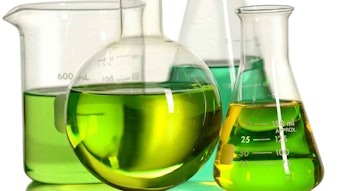One’s sense of taste and smell determines his or her sensory impression of food, and of the traditional senses, smell is the main determinant of a food’s flavor. The taste of food is generally described as sweet, salty, sour, bitter and/or savory, and while the flavor of food does often relates to its smell, this does not always hold true. For example, something that tastes bitter might smell sweet. Therefore, the taste of a food can be enhanced by the addition of a flavor or flavorings. Taste rarely comes into play in cosmetics and personal care formulations; however, flavors—herein synonymous with the term fragrance—often are used to impart a sensorial experience and impression of a specific taste or experiential emotion. In fact, entire product lines are often built around a central fragrance focus.
Taste Sensation
Taste is not typically an important sensory attribute in personal care, except in oral care and lip products, but it is an important attribute in successful food creation. As previously mentioned, there are five primary taste types, each outlined as follows:
Sweet: Sweet is most often associated with the class of chemistry that includes aldehydes and ketones, both of which contain at least one carbonyl group. Additionally, aldehydes and ketones are derived from sugars; e.g., carbohydrates like sucrose, or proteins such as glycine. Sweetness receptors found on the tongue must be activated before the brain registers sweetness. This activation results from the binding of hydroxyl groups (OH) of sugars or proteins to different sweetness receptors, and depending on the degree of binding, the perception of sweetness varies. In personal care applications, sweetness, along with spicy tastes (i.e., mints, fruits, etc.), are sometimes used to create an appealing experience.
Salty: Associated with the presence of sodium ions, the sensation of saltiness is imparted by low molecular weight salts, such as sodium chloride, otherwise known as table salt, and other salts to a lesser degree, including potassium chloride. Generally salt is added to food; however, varying amounts of salt appear naturally in foods such okra, celery, and beets.
Sour: Sourness is associated with the detection of acidity (acids = H+); an example is the hydrolysis of acids in the presence of water to generate hydrogen ions. The hydrogen ions cause an electrical current through the tongue; an excessive current can also be perceived as bitter. Examples of foods commonly associated with a sour taste include lemon, lime and depending on their stage of ripeness, grapes, grapefruit and oranges. A beverage that is commonly associated with sour taste is sour milk.
Some organic acids—i.e., compounds with an acidic property and associated with a carbonyl group—can be used to increase the sourness of food. Examples include:
- Acetic acid, a simple carboxylic acid, well-known for giving vinegar its sour taste and distinctive sharp odor;
- Citric acid, a weak acid that is present in fruits and vegetables, primarily in citrus fruits, that is well-known for its natural preservative characteristics;
- Lactic acid, commonly known as milk acid, which is characterized by a hydroxyl group adjacent to the carbonyl group;
- Malic acid, a dicarboxylic acid that is known for being very tart; and
- Tartaric acid, a white crystalline diprotic acid containing two available hydrogen atoms that are capable of dissociation; tartaric acid is commonly found in wine and is known for its antioxidant properties.
Bitter: Relating to an unpleasant, distasteful taste, bitter is difficult to define. It is generally thought that, when one finds something to be distasteful, his or her body is cautioning them not to eat or drink the substance. Common foods and beverages considered to be bitter include unsweetened chocolate, bitters, citrus peel, quinine water and some coffees, wines and beers. Generally, anything containing alkaloids—a class of naturally occurring, complex organic compounds that typically contain one or more nitrogen atoms in a heterocyclic ring—tastes bitter. This holds true for quinine water and some coffees and medicines.
Savory: Savory, or umami in Japanese, is considered as something delicious in flavor. Generally characterized as brothy or meaty, it is classified as a flavor enhancer. Common savory enhancers typically are represented by the sodium or calcium salt of an amino acid—a molecule containing both amine and carboxyl functional groups. Examples of savory amino acids include:
- glutamic acid salt, a non-essential amino acid, e.g., monosodium glutamate (MSG); one of 20 proteinogenic amino acids;
- glycine, a simple amino acid that is the smallest of 20 proteinogenic amino acids; it usually is used in conjunction with glutamic acid;
- guanylic acid salt, a nucleotide salt, usually used in conjunction with glutamic acid; and
- inosinic acid or inosine monophosphate salt, a nucleotide that is important to metabolism.
Flavor Sensation
As noted, in cosmetics and personal care formulations, tastes are rarely employed; however, flavors are used to impart characteristic aromas. For instance, many lip products include taste flavors while most shampoos include fragrances to impart a pleasant sensory experience.
With regard to flavoring, there are three principal types. Natural refers to substances obtained from plant and animal origin through physical, microbiological or enzymatic processes. Nature-identical refers to substances that are synthetically produced and chemically identical to natural flavors, and artificial refers to substances that taste or smell the same as natural substances but whose chemical structures are unlike the natural substances. As denoted by their classification, artificial substances are not natural. The foods industry has had a longer time to work through the definition of what is considered natural or organic. With current widespread confusion among personal care consumers and manufacturers regarding the definition of natural,1 the cosmetics and personal care industry might benefit from considering the language and definitions adopted by this industry.
The production of natural plant flavors varies from traditional harvesting to the fermentation of natural substrates using modern biotechnology. Once crops are harvested, natural flavor essences are extracted using methods such as distillation, expression or skimming. After purification, extracts can be added to food products for flavoring. To produce nature-identical and artificial flavors, manufacturers first must identify what the individual naturally occurring aroma chemical structures are and mix them appropriately to produce a desired flavor, or create a novel non-toxic artificial compound that simulates a specific flavor’s taste and/or smell.
Most flavor compounds are sensitive to heat and susceptible to reacting with other ingredients in a formulation, which can modify their chemistry and thus the aroma. This is because their structures can contain reactive substituents, e.g., carboxylic groups, or can break down with the application of heat or other ingredients, e.g., acids, bases, etc. Therefore, as with cooking, formulating with flavors requires careful process consideration; it is important to understand the maximum heat tolerance of these compounds so as not to convert them into something that smells acrid or tastes differently than expected.
Science of Seasoning
Similar to flavoring food is seasoning food. Taste obviously is a sense, and one way to generate a taste is through the seasoning of food with ingredients such as spices and herbs. With seasoning, the taste and flavor of food are enriched and/or enhanced. Seasonings are added to recipes to add savoriness, tang and zest. In addition, they are used medicinally and in perfumes. Seasoning generally relates to herbs, spices and condiments. Of these categories, essential oils, which have complex compositions, are of the most significance to personal care.
Although essential oils are mostly noted for their aromatic compounds, which contribute aroma and flavor, other key compounds are present. For example: alcohols, which are high molecular weight fatty alcohols; phenolics including flavoroids, terpenes and curcuminoids; carboxylic acids such as citric, fumic and benzoic acid; and carbohydrates, primarily glucose and fructose sugars. Most of these compounds are soluble in cooking oils, thus herbs and spices often are soaked in oil (e.g., olive oil) to release or extract their fine-smelling/tasting essential oils. When soaking herbs in oil, it is best to use whole, fresh leaves; when soaking spices in oil, it is best to use whole or ground spices.
One might draw a comparison between seasonings and personal care additives. Additives can be used in personal care to enhance a product’s performance or improve its look and feel and thus consumer perception. Examples of this are: botanical additives that provide a natural performance or instill an emotional expectation of performance; salts or glycolics to enhance the salvation of an ingredient in water; colors and flavors/fragrances to impart visual and olfactory perception; and controlled salt content in a surfactant system to manage viscosity.
Herbs: Herbs represent the leaves and stems of soft-stemmed plants to enrich edible food. Herbs have distinct flavors and perfumes and are best used when fresh, in order to extract the optimum potency of the herb; however, they also can be used dry. Falling within this category are basil, bay, oregano, chives, marjoram, rosemary and thyme.
Spices: Spices represent the aromatic components of dried seeds, roots, rhizomes, bark, flower buds, fruits and arils of edible plants or plant parts. Examples include: nutmeg and cumin from dried seeds; horseradish from a plant root; ginger/turmeric from plant rhizomes; cinnamon from tree bark; cloves from tree flower buds; paprika from dry fruit; and mace from fruit arils. There are a number of soft-stemmed plants that, depending on which part is used, fall into both herb and spice categories. Examples include coriander, dill and fennel.
Further, spices can be classified as either sweet or hot. Sweet spices, for example, include cinnamon, cloves, allspice, ginger, cardamom, anise and fennel. Although not necessarily sweet, when blended with sweet ingredients like sugars, these spices can reduce the amount of sugar required in a recipe. Hot spices include, but are not limited to, white pepper, black pepper, peppercorn, paprika, curry powder and chili/cayenne peppers. Items from this group are used to heat and intensify recipes.
Condiments: Made up of herbs and/or spices, condiments typically include salty, spicy and/or savory flavors and are considered seasonings because they add distinctive flavors and aroma, whether applied during the preparation of a dish or to something already prepared. Condiments include some sauces (e.g., soy sauce) and relishes. Obviously, many regions of the world have their own typical condiments, ranging from piccalilli relish, mustard, ketchup, chutney, salsa and mayonnaise, to guacamole, Tabasco sauce, Worcestershire sauce and horseradish.
The making of condiments is similar to compounding fragrance and analogous to cosmetic personal care formulating, in which flavors and tastes are substituted for textures/esthetics; the final composition is influenced by the combination of ingredients, the process itself, consistency and applicability. And likewise, the synergy of blended ingredients elicits a unique functional benefit. For example, the use of blends in surfactant systems enhances surfactant activity and rinse-ability; preservatives enhance broad spectrum antimicrobial activity; and blends of sunscreens broaden SPF protection.
Other seasonings (saline and acidic): Other seasonings include those that are saline and acidic. The saline group includes: salt (e.g., table salt or sodium chloride); spiced salt or salt in combination with a spice; and saltpeter, i.e., sodium or potassium nitrate. Saline products mainly are used to enhance a dish’s flavor, to tenderize meat, or to cure or preserve food. When used in food preservation, salt acts to absorb water from meat or fish.
Water activity (Aw) can be defined as the amount of biologically available water to the microbial population and its ability to reproduce. It can be described as the vapor pressure of a sample divided by the vapor pressure of pure water, and can be measured with a dew point instrument. In cooking, salting, pickling and drying of foods, salt helps to reduce the water activity and thus improve the preservation potential.
In cosmetics, alcohol, glycols, sodium chloride and non-aqueous solvents can be used to drive down the water activity and boost the preservation ability of preservatives. A quick water activity reading can provide valuable information in minutes prior to running a preservation efficacy test. In addition, salt aids in the stretching of hydrogen bonds and enlarging of associative thickener molecules, thus increasing the viscosity of the aqueous phases of a formula. For instance, salt is applied to shampoo formulations to modify viscosity.
Within seasonings, the acidic group includes plain vinegar, vinegar aromatized with spices such as tarragon, rice vinegar, wine vinegar, balsamic vinegar, apple cider vinegar and verjuice—an acidic juice made from pressing unripe grapes. Depending upon the dish, use of an acidic seasoning can unlock its hidden aromas and flavors. Though there is no direct analogy in formulating cosmetic personal care products with an acidic compound to increase its aromas and flavor, acidic compounds commonly are used to adjust the pH of a formula, to modify its viscosity, to enhance preservation, and to increase emulsifier efficiency.
Not discussed herein but of note is the use of saccharine seasonings—i.e., sugars, honey and corn syrup—to enhance the flavor and aroma of foods. For convenience, herbs and seasonings are often pre-blended and used to impart a regional experience—i.e., Mexican, Italian, Oriental, etc.—or are indicated to optimize the flavor of certain foods.
Timing Considerations
The timing for introducing an herb, spice, condiment or herb/spice blend into the cooking process is important since it can affect the quality of taste and aroma. For best results, robust herbs such as sage, thyme and bay leaves prevail during longer cooking processes while milder herbs like basil, marjoram and parsley can be added to recipes at the last minute. For optimum flavor, it is recommended that spices such as fennel seed, cumin seed, sesame seed and white peppercorns be toasted to enhance their flavor contribution to food.
In cosmetics and personal care formulating, it would seem obvious to add temperature-sensitive ingredients such as fragrance and preservatives later in the process when the temperature is significantly reduced (below 50°C or preferably 40°C) and close to room temperature to minimize any alteration to these essential ingredients. Unfortunately, due to the complexity of fragrance and preservative compositions, color, odor and stability are potentially at risk. The better formulators understand what is being incorporated into the formula, the higher the probability of developing successful products.
Conclusions
The flavoring and seasoning of food to elicit a unique taste and smell closely resembles what occurs during the formulation of cosmetics and personal care products. Consumers are in tune with the appearance of personal care products, which relates to their expectations for performance. Therefore, understanding how to work with colors, fragrance/flavors, preservatives and viscosity/rheology modifiers is critical not only to successful food preparation, but also to the formulation of shampoo, moisturizer hair conditioner, nail polish and so forth.
This completes a four-part series on “Cooking Chemistry and the Formulator,”2-4 in which relationships between cooking chemistry and personal care product development have been made to inspire new approaches to cosmetic chemistry. The sources for ingredients, the timing and order of their addition to a formula/recipe, and their use to improve the look, feel and aroma (or taste) of a product have been made throughout the discussion, since thinking about the chemistry helps formulators to optimize products by providing a clearer understanding of each ingredient’s value and contribution to the finished product.
References
1. E Abrutyn, Anatomy of a Formula: Building Naturals, Cosm Toil 124(10) 20–24 (Oct 2009)
2. E Abrutyn, Cooking chemistry and the formulator: Egg whites and milk, Cosm Toil 124(3) 24–28 (Mar 2009)
3. E Abrutyn, Cooking chemistry and the formulator: Red and White Meats and Fish, Cosm Toil 124(6) 20–25 (Jun 2009)
4. E Abrutyn, Cooking chemistry and the formulator: Grains and Sugar, Cosm Toil 124(8) 18–23 (Aug 2009)










